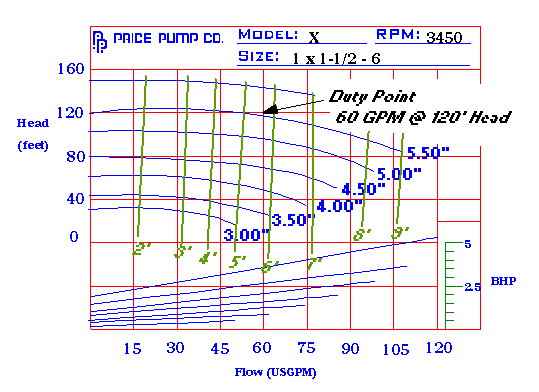
Lesson Three - Cavitation and NPSH
Contents
Cavitation
Cavitation is a phenomena which occurs when a liquid vaporizes as it passes through a pump and then quickly turns back into a liquid. The collapse of the vapor bubbles creates destructive microjets of liquid strong enough to damage the pump. Vaporization occurs if the pumped liquid drops below its vapor pressure. As a liquid accelerates through a pump it loses pressure (Bernoulli’s Principle). If the pressure drops below the vapor pressure of the liquid then gas bubbles will instantly form as the liquid vaporizes. These bubbles just as quickly collapse, causing cavitation to occur. To prevent cavitation the pressure (more correctly the head) of the liquid entering the pump must be high enough to prevent the subsequent liquid pressure drop from reaching liquid vapor pressure.
NPSH
A minimum amount of suction pressure (head) is needed for a pump to operate without cavitating. The term used to describe this suction pressure is Net Positive Suction Head (NPSH). The amount of NPSH the pump requires to avoid cavitation is called NPSHR. The amount of NPSH available to the pump from the suction line is termed NPSHA. The chart shown below has NPSHR lines highlighted in green. When selecting a pump it is necessary to see how much NPSH it requires at the duty point and make sure the NPSH available exceeds that amount. For example, in the curve below, a pump operating at 60 gpm and 120 feet of head would require nearly 6 feet of NPSH available at the suction port to avoid cavitation. It is normal practice to have at least 2 feet of extra NPSH available at the suction flange to avoid any problems at the duty point. Also, if the pump were inadvertently operated at a flow higher than the rating point then a higher NPSH would be required to avoid cavitation.

Contents
Cavitation
Cavitation is a phenomena which occurs when a liquid vaporizes as it passes through a pump and then quickly turns back into a liquid. The collapse of the vapor bubbles creates destructive microjets of liquid strong enough to damage the pump. Vaporization occurs if the pumped liquid drops below its vapor pressure. As a liquid accelerates through a pump it loses pressure (Bernoulli’s Principle). If the pressure drops below the vapor pressure of the liquid then gas bubbles will instantly form as the liquid vaporizes. These bubbles just as quickly collapse, causing cavitation to occur. To prevent cavitation the pressure (more correctly the head) of the liquid entering the pump must be high enough to prevent the subsequent liquid pressure drop from reaching liquid vapor pressure.
NPSH
A minimum amount of suction pressure (head) is needed for a pump to operate without cavitating. The term used to describe this suction pressure is Net Positive Suction Head (NPSH). The amount of NPSH the pump requires to avoid cavitation is called NPSHR. The amount of NPSH available to the pump from the suction line is termed NPSHA. The chart shown below has NPSHR lines highlighted in green. When selecting a pump it is necessary to see how much NPSH it requires at the duty point and make sure the NPSH available exceeds that amount. For example, in the curve below, a pump operating at 60 gpm and 120 feet of head would require nearly 6 feet of NPSH available at the suction port to avoid cavitation. It is normal practice to have at least 2 feet of extra NPSH available at the suction flange to avoid any problems at the duty point. Also, if the pump were inadvertently operated at a flow higher than the rating point then a higher NPSH would be required to avoid cavitation.
